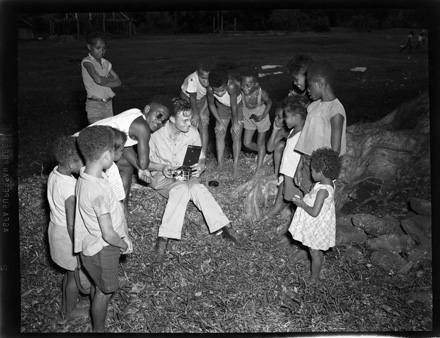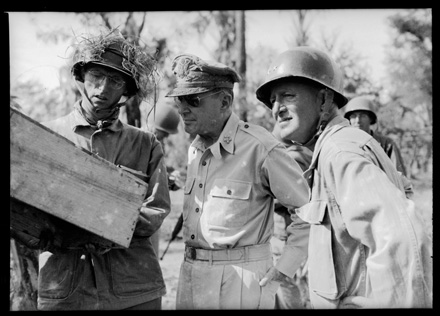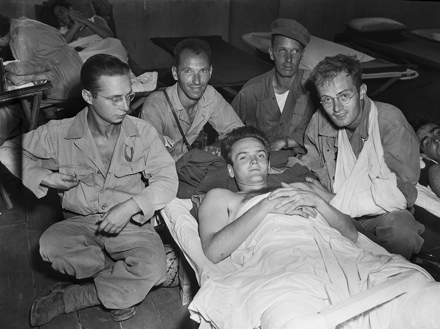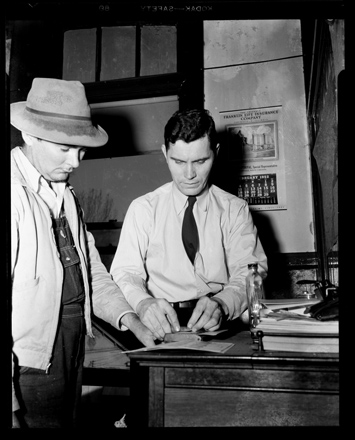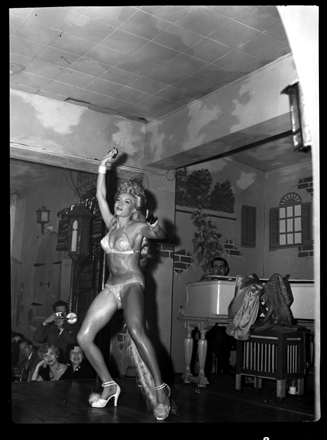It’s a busy Morton-related week: a special episode of UNC-TV’s Exploring North Carolina featuring Hugh Morton and Grandfather Mountain will air statewide for the first time tomorrow evening, Thursday, March 5, at 8:30 PM and again on Friday, March 6, at 9:30 PM. Host Tom Earnhardt describes the program as “a mix of biography, biodiversity, geology and Hugh Morton’s phenomenal photographs from the North Carolina Collection at UNC-Chapel Hill.”
I worked with Tom to select and provide photos for the episode (such as the ones included here), so I’m excited to see it — and I hope you’ll tune in too.
Category: Biography
Aloha Kalikimaka
After making it through a rather blustery November, I’m reminded of when I boldly decided to escape the cold Sierra Nevada Mountains and relax on the black sand beaches of Hawaii. The Mortons had the same brilliant idea over Christmas 1978, when they took a trip to the islands of Oahu and Kauai. There are stunning pictures of double rainbows over a misty Honolulu, the USS Arizona Memorial, and surfing crystal turquoise waters.
While in Hawaii, Morton visited the grave of Ernest Taylor Pyle at the National Memorial Cemetery of the Pacific. Ernie Pyle was a journalist in both world wars, stationed in the Pacific Theater during WWII. I’m guessing that their paths must have crossed during that time? I haven’t been able to find a connection, but if anyone can confirm this it would be appreciated.
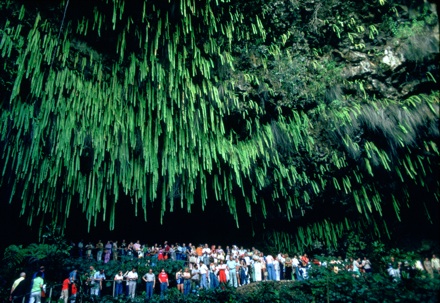
The photo above I found floating loose at the bottom of a box, one of the many orphans I have had to match to its roll. Once I found the Hawaii batch, I was able to easily recognize where it belonged. It shows the Fern Grotto in Wailua River State Park on Kauai — this is a large lava cave that ferns took over, growing on every surface. I’m not certain if Hugh had pulled this from the rest of the roll for a presentation, or because he felt it wasn’t up to par. (His “rejects” usually look pretty great to me).
In the late 70s and early 80s, Hugh took numerous photos of hang gliding, mostly at Grandfather (the home of the National Hang Gliding Championship for a few years). The comments we received on a previous post tell the exciting story behind one of the hang gliding photos from Hawaii, which shows Morton himself taking flight! The image above was one that was able to capture the beautiful waters, and the contrast between the white sands and dark coral reefs.
Maybe it’s the temps in the 20s forecast for Chapel Hill, or the thought of a Mai Tai, but Hawaii is definitely calling for me to visit again soon. Right, Elizabeth?
Editorial Note from Elizabeth: I thought it was pretty funny when Amber said she wanted to write this post, because I am actually off to Hawaii myself next week! I’ll be doing, um, highly serious and intensive Morton-related research. No relaxing whatsoever. (Do you think the IRS will buy that?)
Highway 17
A couple of weeks ago, I went to spend a few leisurely days with my family at Sunset Beach, NC. The idea, of course, was to get away from it all—little did I realize that when one’s job centers around Hugh Morton, it’s impossible to drive on North Carolina’s highways without being constantly reminded of work! Highway 17 near Wilmington is especially bad. Nearly every road sign I saw reminded me of Morton—Castle Hayne, St. Helena, Holden Beach, Orton Plantation, the State Ports, and of course the USS North Carolina, which we drove right by (twice!) . . .
View Larger Map
The image below shows (I believe) Morton’s wife Julia and a little girl (maybe their daughter Catherine) in a field of daffodils at Castle Haynes (over time, it seems, the “S” has been dropped from the place name). Morton took many a portrait in these highly photogenic flower fields.
The story of Castle Hayne(s) and St. Helena is a fascinating one: Hugh MacRae, Morton’s grandfather, founded these two experimental colonies around the turn of the 20th century, with the goal of attracting European immigrants to introduce their systems of intensive agriculture to the Southeast. In a March 1934 article from The State magazine, MacRae is quoted as saying, “I feel sure that we have got to rebuild our economic structure beginning at the base, which means a reshaping of rural life.”
Farm families from countries including Greece, Russia, Italy, Holland, Germany, Poland, and Hungary transplanted themselves to New Hanover and Pender counties to begin new lives, and many proved highly successful. From the March 10, 1934 The State article: “While the cancerous depression was eating the core out of farming financially and otherwise all over the United States, these colonies were teeming with prosperity in comparison.” (Note: anyone interested in learning more about MacRae’s experiment and similar settlements should track down the following article: “A Reconnaissance of Some Cultural-Agricultural Islands in the South,” by Walter M. Kollmorgen, Economic Geography Vol. 17, No. 4, Oct. 1941, pp. 409-430.)
While the Hugh Morton image below is labeled simply “Dutch Girls,” I feel certain it was taken at Castle Hayne, sometime during the 1940s:
I’m less certain about the following Morton image, which is one of a batch of negatives I found in an envelope labeled “Estonians.” It shows what I assume is a group of immigrants or visitors from Estonia, taken probably on the Wilmington waterfront during the 1940s. Were these people coming to settle at MacRae’s colonies? I have no idea. (If it helps anyone with identification, a building in the background reads either “Maffitt…” or “Haffitt…”).
Later articles from The State (from the 8/11/1945 and 11/16/1957 issues), reinforce the notion that this particular experiment proved beneficial to the region’s economy. I don’t know much about what’s going on in St. Helena and Castle Hayne these days, other than what I learned from a recent article in the Wilmington Star News about the possible closure of the Castle Hayne Horticultural Crops Research Station. Can anyone help bring us up to date?
You see how easy it is to get caught up in just one of the roadside locations along Highway 17. Perhaps I’ll explore others in future posts.
Remembering WW2
Memorial Day seems a most appropriate occasion to highlight some of the images documenting Hugh Morton’s World War II experiences. The broad strokes of the story are well known: aware that he would end up in the military and hoping to receive an assignment in photography, Morton enlisted in October 1942 and was first posted at the U.S. Army Anti-Aircraft School at Camp Davis, taking pictures for training manuals.
When he was sent to New Caledonia to report to the 161st Army Signal Corps Photo Company, he was surprised when his captain looked at him and said, “Morton, you look like a movie man.” (This was the first time he picked up a movie camera, but it certainly wouldn’t be the last—future blog posts will explore some of Morton’s later adventures in filmmaking). Since his wartime film footage went directly to the Army, we don’t have any of it in the collection here at UNC—but we do have a small number of still images taken by and of Morton during these eventful years.
Here’s Morton, in a photo by an unknown photographer, with his movie camera atop a B-24, the “Go Gettin’ Gal“:
In 1944 Morton obtained an enjoyable assignment covering Bob Hope, Frances Langford, and Jerry Colonna as they entertained the troops at New Caledonia. In the booklet Sixty Years with a Camera, Morton described these as “three of the happiest days of my life…I rode in the same car with Bob and Jerry…during which they were cracking jokes and practicing their lines. It was a fun time.”
From there, he was sent briefly to Guadalcanal and Bougainville, which may be when the following images were snapped (the first is by Morton; the second shows Morton with his camera and a group of Pacific island children, taken by an unknown photographer):
Morton then got his most intense assignment when he was sent to photograph the 25th Infantry Division as they invaded Luzon, in the Philippines, in early 1945. He obtained a few still shots of combat, and covered General Douglas MacArthur when he came to Luzon to inspect the 25th Division:
Shortly after MacArthur’s visit, Morton was wounded in an explosion—an incident for which he received a Purple Heart and Bronze Star, with citation, for exposing himself to danger in order to obtain high-quality, closeup images of the front lines. Morton recounts the incident in UNC-TV’s “Biographical Conversations” (video available online), claiming that the Speed Graphic camera he held in front of his face helped save him from further injury.
A note of interest: the Library of Congress holds the papers and photos of another member of the 161st Photographic Company, Charles Rosario Restifo. Be sure to check out Restifo’s detailed autobiography, wherein he discusses his training, camp life, and experiences in the Pacific, many of which would have been similar to or the same as Morton’s. I don’t believe Restifo is in the picture above, and he doesn’t mention Morton by name in the memoir, but it sounds like they were on many of the same assignments—in fact, if you look on page 98 of Restifo’s book, the image of MacArthur appears to be the exact same image as Morton’s (above)! Not just similar, but identical. Not sure how this happened.
One last Memorial Day musing: Morton didn’t leave his WW2 experiences behind him when he left the Pacific. As I discussed in a previous blog post, he deserves a lot of credit for the establishment of the USS North Carolina as a memorial to North Carolinians who died in WW2 service.
The Klan in NC
It’s another of those “1,000 word” moments, where a Morton image sends me off on a journey of discovery. On my recent visit to Grandfather, Hugh’s wife Julia told me the following story: she and Hugh got a speeding ticket in 1945 while driving through Columbus County, NC, on the way back home after their honeymoon. A few years later, Hugh was assigned to photograph the arrest of a supposed K.K.K. leader in Columbus County—Morton went to the jail, and to his surprise the man being arrested turned out to be the same man who had given them the speeding ticket. Mrs. Morton couldn’t quite recall his name, but thought it was “Early Bird” or something odd like that.
So, when I saw the negative envelope labeled “K.K.K.,” I thought to myself, maybe these are the negatives Mrs. Morton mentioned . . . and indeed, they do show a man being fingerprinted. I noted that the calendar on the wall read Whiteville, NC (in Columbus County), February 1952.
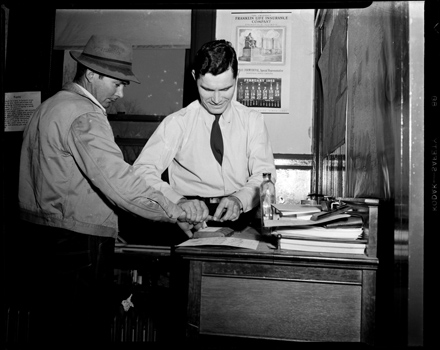
To my surprise, a quick web search for the K.K.K. in this time and place returned a bounty of fascinating information. First I learned that the 1953 Pulitzer Prize for Public Service in Journalism had gone to the Whiteville News Reporter and Tabor City Tribune, two weekly newspapers, “For their successful campaign against the Ku Klux Klan, waged on their own doorstep at the risk of economic loss and personal danger, culminating in the conviction of over one hundred Klansmen and an end to terrorism in their communities.”
Then I read about something called the Carter-Klan Documentary Project, being run right in our backyard at the UNC Center for the Study of the American South. This is an effort begun in 2003 to create a documentary film and other multimedia elements about the work of W. Horace Carter (then editor of the Tabor City Tribune) and others to combat the early 1950s Klan insurgency in Columbus County, led by Grand Dragon Thomas Hamilton. The timeline on the project’s detailed website describes the events of February 16, 1952, when “more than 35 FBI agents, working in close coordination with state and local law enforcement officials in Columbus County, N.C., arrest 10 Klansmen for the kidnapping and flogging of Ben Grainger and Dorothy Martin on October 6, 1951,” and says that several other area Klansmen were arrested from February to May of 1952.
Far down on the Thomas Hamilton page, I found a photo (below, from the Raleigh News & Observer) and description of Early Brooks, a former Fair Bluff policeman who led “the most vicious and active klavern” in Columbus County. “Eureka!,” I exclaimed to myself, a former policeman named “Early”—this has to be the guy. But when I compare the photos, I actually don’t think it is the same person. What do you think? If it’s not Early Brooks, who is it? And who is the arresting officer?
One last note about all this: in searching the UNC libraries catalog for information about W. Horace Carter, I found an oral history interview conducted with Carter in 1976 as part of the Southern Oral History Program (available online, both audio and transcript). Turns out Carter and Hugh Morton went to UNC-Chapel Hill at the same time—Carter was editor of the Daily Tar Heel in 1944, and Morton took photos for campus publications . . . surely they knew each other. Did Carter give Morton the assignment in 1952? Was the photo published? I hope someone can fill in the details.
Worth 1,000 words
If there’s one thing “A View to Hugh” has made clear, it’s that every photograph has a story behind it—especially if it was taken by Hugh Morton. My recent visit with Hugh’s wife Julia, daughters Judy and Catherine, and grandson Crae really impressed this point upon me. Mrs. Morton could barely finish telling me one story before launching into another (I tried to take notes, but eventually gave up). I do remember one set of photos she mentioned, of the “Cat Girl,” a New Orleans burlesque performer Hugh went to see on one of his trips to the Sugar Bowl with the Charlie Justice team in 1947. Here she is:
The website FrenchQuarter.com has a tidbit about “exotic dancer Lilly Christine the Cat Girl”—that must be her! According to Mrs. Morton, Hugh didn’t care for cheesecake photography, and “wasn’t good at it”—he was apparently pressured, against his will, to go see the Cat Girl by a group of friends that included then-mayor of Chapel Hill, Robert W. Madry.
This is just one example. As great as the stories are, the difficulty is that 500,000 images in the Morton collection equals a heck of a lot of stories—a lifetime’s worth, from a very full lifetime. (Using the “1,000 words” estimate, that’s 500 million words!!) Uncovering and documenting all these stories is one of the major processing challenges we face.
Fortunately, we have people to draw on, like Hugh’s family, friends, acquaintances, and other readers of this blog. And we have other sources, too, like one I just got around to looking at—that fabulous magazine The State (now known as Our State), in which Morton photos were very frequently featured. Here in the North Carolina Collection, we’re lucky enough to have not only the entire run of the magazine, but also subject indexes, and (thanks to some wonderful guy named Robert M. Topkins) a 1976 index to pictures appearing in The State.
Morton was friends with the original publisher Carl Goerch, as well as his successor Bill Sharpe, whom Morton has described as “the one person who most whetted my interest for making pictures of and for the state [of North Carolina].” This photo of Goerch, Sharpe, and Sharpe’s wife appeared on page 7 of the August 19, 1950 issue of The State, along with the text quoted below.

As you look at this picture you can almost guess the words that might have been spoken:
Says the lady: “You numbskull! You nit-wit! You’ve got no business on this beach. Now get yourself away from here just as quickly as you can, before I call a policeman. Git, I tell you; git!”
Says the man in the bathing trunks: “But lady, I didn’t mean any harm! Goodness knows I didn’t. When you were stooping over, picking up shells, I thought you were my wife. That’s the reason I spanked you.”
Says the lady: “I don’t want to hear anything further from you. On your way before I call a cop!”
Says the man with the marine cap, the dark glasses, the checkered shirt, the rolled-up trousers and the slightly protruding stomach: “That’s tellin’ him, mamma: that’s tellin’ him!”
The lady happens to be Mrs. Bill Sharpe. The man in the bathing trunks happens to be the editor of this publication. The man with the marine cap and all the other accessories, including the slightly protruding stomach, happens to be Bill Sharpe. And Hugh Morton of Wilmington just happened to be around just in time to take the picture.
I guess if you don’t know the story behind a picture, you can always make one up . . .
Who Am I?–North Carolina Azalea Festival Edition
 Wilmington’s 61st annual North Carolina Azalea Festival kicks off next week (April 9-13). Hugh Morton played an integral role in the event’s founding: while only in his twenties, he was selected to serve as president of the inaugural festival in 1948. (A letter from Morton on the festival’s website explains that when he missed a committee meeting, they responded by electing him president). As Susan Taylor Block writes in “Clan MacRae,” an article in the 4/2007 issue of Wrightsville Beach magazine, Morton deserves credit not only for Wilmington’s Azalea Festival, but also many of its azalea plants:
Wilmington’s 61st annual North Carolina Azalea Festival kicks off next week (April 9-13). Hugh Morton played an integral role in the event’s founding: while only in his twenties, he was selected to serve as president of the inaugural festival in 1948. (A letter from Morton on the festival’s website explains that when he missed a committee meeting, they responded by electing him president). As Susan Taylor Block writes in “Clan MacRae,” an article in the 4/2007 issue of Wrightsville Beach magazine, Morton deserves credit not only for Wilmington’s Azalea Festival, but also many of its azalea plants:
Morton had worked diligently since 1946 to make the 1948 Azalea Festival debut a success. He encouraged Wilmingtonians to plant azaleas, persuaded the local government to plant an additional 175,000 azaleas at Greenfield Lake and recruited garden clubs to transplant azaleas from their own private gardens to public spaces. Morton encouraged the festival fathers to be careful stewards of the event’s ticket take, seek out quality in celebrity guests and make the azalea itself the guest of honor. He knew that if the first festival ended up in the red, it would be the last.
North Carolina Azalea Festival negatives in the Morton collection are numerous and mostly in good shape, but not well-documented. The early years of the festival (from 1948 to about 1958) are best represented, but little identifying information is provided other than the year (if that). Fortunately, we have at least one good source to work from—historian Block’s 2004 book Belles & Blooms, heavily illustrated by Morton’s photos. Block’s time line will help us pin down some of the major details, like who was queen in what year, what celebrities attended, etc.
In the meantime, though, we’re asking you to help us put names to faces in some of these early shots.
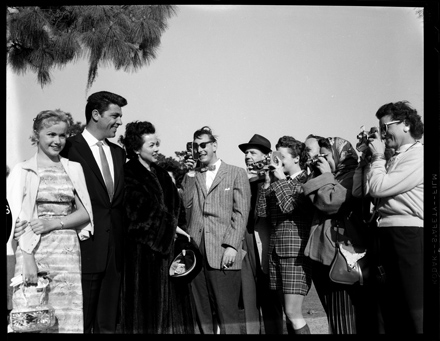
Judging from the enormous fur coat and all the cameras pointed at them, I’m guessing that these people are famous. But who are they?
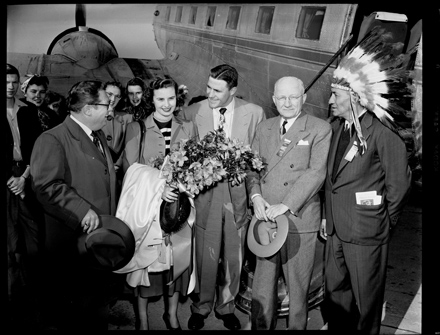
The image above was taken at the 1950 Azalea Festival. I can’t read any of the name tags, but I do see that the man on the far right (in the headdress) has a program from “Unto These Hills” (an outdoor drama performed at Cherokee, North Carolina) in his pocket.

The man in this photo is Grady Cole, talk radio celebrity with WBT Radio in Charlotte, North Carolina (and frequent Morton photo subject in the early 1950s). But who is the woman—and is she the same woman from the previous photo? Most importantly, why are they holding up what looks like an x-ray of somebody’s spine?!
Happy Birthday to Hugh
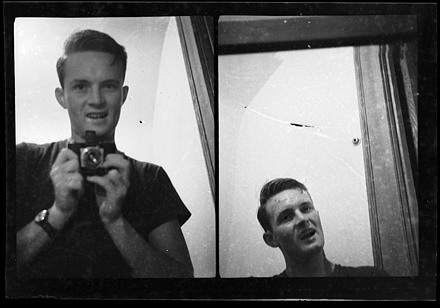
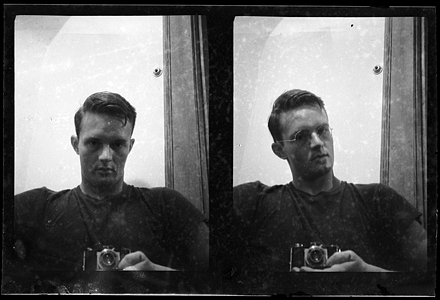
In honor of what would have been Hugh Morton’s 87th birthday today, I decided to share this set of self-portraits I recently stumbled upon—the only images in the collection I can remember seeing that are both of and by Morton. I love how they capture multiple sides of his personality—the fun, happy Hugh on top, and the Hugh on the bottom that you probably don’t want to mess with.
Dating probably from the late 1930s, these negatives are a somewhat unusual format: a non-perforated roll film with an image area measuring 1 1/4-inch by 1 1/2-inch (or 30 x 40mm). Most of the negatives of this format in the collection are deteriorating such that the film has turned blue, with blue splotches throughout.
Some quick research had led me to think that this might be film for a Kodak 35, the first 35mm camera made by Kodak. Since Morton so conveniently included his camera in the shots, we have more evidence to draw from. Unfortunately, these shots are largely out of focus, and while the camera looks pretty similar to the Kodak 35, it doesn’t look exactly like any of the models I can find online (specifically, the silver plate with squared corners behind the lens doesn’t look right). And, of course, the film size isn’t right either; the only film format I can find that meets the 30 x 40mm dimension requirement is 127. Could this be a half-frame 127 camera?
To further complicate matters, I see in David Horvath’s extremely useful Acetate Negative Survey that, “In Agfa/Ansco products, a blue anti-halation dye which was converted to a luco base during processing was used. It is generally colorless but is turned blue again by the action of mold or acids. Many degraded Agfa/Ansco negatives exhibit this distinctive blue color.” So, this leads me to wonder if this is an early Agfa/Ansco camera—but again, I can’t find any matching models online, and the film maker and the camera maker don’t have to be the same.
As usual, I’ve gotten way more wrapped up in this than I intended to. Any insight from you vintage camera buffs, or from other archivists who may have seen this format before?
A "Photographer’s Photographer"
One of the many titles bestowed on Hugh Morton over the years is “the father of North Carolina photojournalism education.” He was a charter member of the National Press Photographers Association and president of the North Carolina Press Photographers Association. Appealing to a broader audience, Morton founded in 1952 the annual Grandfather Mountain Camera Clinic for amateurs and professionals, and the Nature Photography Weekend, also hosted by Grandfather Mountain.
Perhaps most notably, Morton was a founder and the first chairman (1950-1965) of the Southern Short Course in Press Photography. Now known as the Southern Short Course in News Photography, this training program for students and professionals is the country’s longest-running seminar in photojournalism. The images below are from the early years of the Short Course, probably 1951-1953, when it was held at the University of North Carolina at Chapel Hill. The first image shows Joseph Costa (left, in bow tie), well-known American newspaper photographer, photography lecturer at Ball State University, and a founder of the National Press Photographers Association; the other man presenting (back to camera) appears to be Hugh Morton. Since most audience members are wearing name tags, this image is handy for identification purposes. (Few of the names are legible, however, and none at the resolution presented here.)
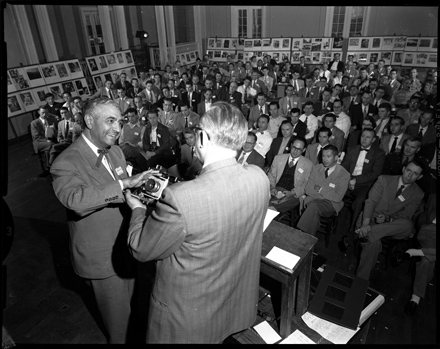
The next image shows unidentified instructors presenting about darkroom procedure. (Sharp-eyed readers of this blog might notice Burlington photographer Edward J. McCauley in the third row, third seat from the left—see Patrick Cullom’s recent post, A Contemporary of Morton).
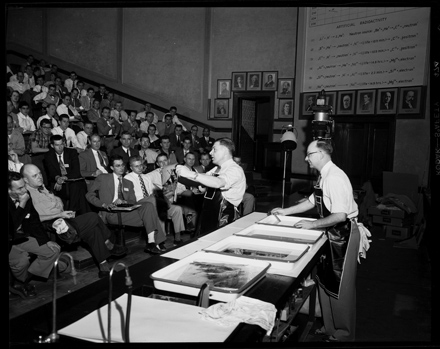
Our blogging compatriot over at the Blue Ridge Blog says, “I’ll always remember Hugh Morton as a photographer’s photographer. He understood the needs of a working photojournalist and went out of his way to make the job easier for us.” Do you have any photojournalism- related memories of Morton to share? Can you provide any information about these early Short Course images?
NC's "Immortal Showboat"
 In honor of the recently-opened exhibit, “Showboat”: The USS North Carolina (BB 55), at the North Carolina Museum of History, and since I just happened to be “passing” through this particular batch of negatives, I decided to highlight a few of my favorite Morton images related to the USS North Carolina.
In honor of the recently-opened exhibit, “Showboat”: The USS North Carolina (BB 55), at the North Carolina Museum of History, and since I just happened to be “passing” through this particular batch of negatives, I decided to highlight a few of my favorite Morton images related to the USS North Carolina.
Morton was enlisted in 1960 by his good friend and then-governor Luther Hodges to spearhead the ultimately successful campaign to preserve the battleship as a memorial to World War II veterans. The article “Saving Our Ship” on the USS North Carolina Memorial Web site provides background on the campaign and Morton’s leadership, noting in particular that “Morton’s drive to control the administrative costs of undertaking such a large campaign led to savings such as using his young son on campaign posters rather than paying for a model.” The image below must be a mock-up of one of those posters. [The boy in the image below is not one of Morton’s sons, but there are images in the collection showing Jim Morton holding a model of the USS NC that were possibly used on campaign posters.]
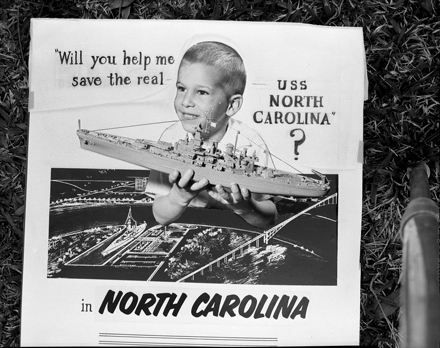
This last image depicts John Weaver working on two busts for the USS NC Museum (likenesses of FDR, Chester Nimitz, MacArthur, and Truman were made—not sure which two these are). [Correction: This is not John Weaver, but a Linville artist named Coffey, and these heads were not created for the USS NC. Just goes to show that an archivist can’t always trust the contextual information that comes with a document! Thanks to Julia Morton for clarifying.]
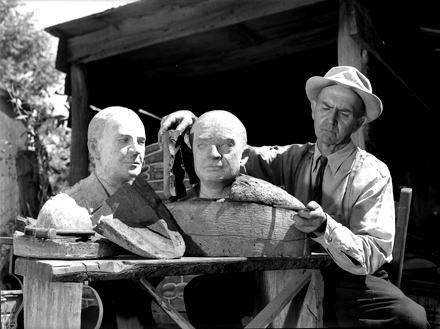
One last note: as I was just proofreading the contents of this post, I happened to notice today’s date: December 6. Tomorrow is the 66th anniversary of the attack on Pearl Harbor. Crazy coincidence strikes again on “A View to Hugh!”

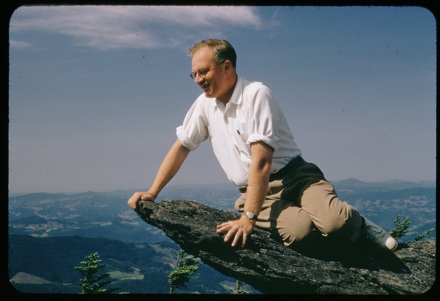

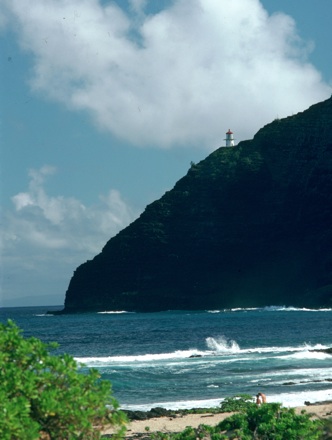
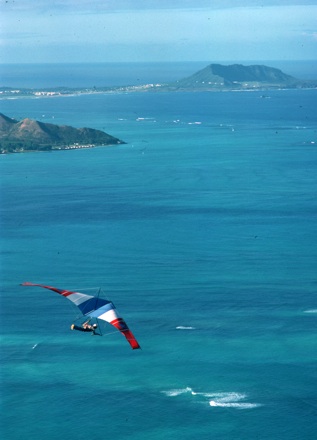
![Julia and Catherine [?] Morton in daffodil field at Castle Hayne[s], NC, circa early 1960s](https://blogs.lib.unc.edu/morton/wp-content/uploads/sites/7/2008/05/castlehaynes.jpg)

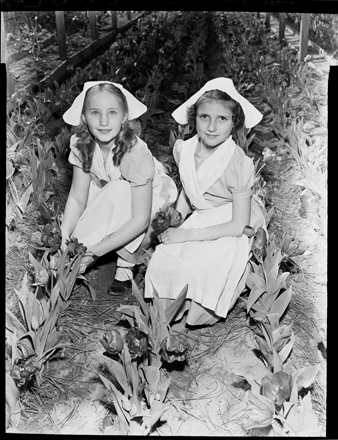
![“Estonians,” Wilmington, NC waterfront [?], circa 1940s](https://blogs.lib.unc.edu/morton/wp-content/uploads/sites/7/2008/05/p081_ntbf3_000141_10.jpg)

![Frances Langford and Bob Hope entertaining military personnel in New Caledonia, 1944 [cropped]](https://blogs.lib.unc.edu/morton/wp-content/uploads/sites/7/2008/05/p081_ntbf4_000136_04.jpg)

